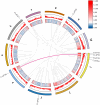Genome-wide identification and analysis of ascorbate peroxidase (APX) gene family in hemp (Cannabis sativa L.) under various abiotic stresses
- PMID: 38685943
- PMCID: PMC11057428
- DOI: 10.7717/peerj.17249
Genome-wide identification and analysis of ascorbate peroxidase (APX) gene family in hemp (Cannabis sativa L.) under various abiotic stresses
Abstract
Ascorbate peroxidase (APX) plays a critical role in molecular mechanisms such as plant development and defense against abiotic stresses. As an important economic crop, hemp (Cannabis sativa L.) is vulnerable to adverse environmental conditions, such as drought, cold, salt, and oxidative stress, which lead to a decline in yield and quality. Although APX genes have been characterized in a variety of plants, members of the APX gene family in hemp have not been completely identified. In this study, we (1) identified eight members of the CsAPX gene family in hemp and mapped their locations on the chromosomes using bioinformatics analysis; (2) examined the physicochemical characteristics of the proteins encoded by these CsAPX gene family members; (3) investigated their intraspecific collinearity, gene structure, conserved domains, conserved motifs, and cis-acting elements; (4) constructed a phylogenetic tree and analyzed interspecific collinearity; and (5) ascertained expression differences in leaf tissue subjected to cold, drought, salt, and oxidative stresses using quantitative real-time-PCR (qRT-PCR). Under all four stresses, CsAPX6, CsAPX7, and CsAPX8 consistently exhibited significant upregulation, whereas CsAPX2 displayed notably higher expression levels under drought stress than under the other stresses. Taken together, the results of this study provide basic genomic information on the expression of the APX gene family and pave the way for studying the role of APX genes in abiotic stress.
Keywords: Abiotic stresses; Bioinformatics analysis; CsAPX gene family; Expression patterns; Hemp.
©2024 Liang et al.
Conflict of interest statement
The authors declare there are no competing interests.
Figures







Similar articles
-
[The role analysis of APX gene family in the growth and developmental processes and in response to abiotic stresses in Arabidopsis thaliana].Yi Chuan. 2019 Jun 20;41(6):534-547. doi: 10.16288/j.yczz.19-026. Yi Chuan. 2019. PMID: 31257201 Chinese.
-
Characterization of APX and APX-R gene family in Brassica juncea and B. rapa for tolerance against abiotic stresses.Plant Cell Rep. 2022 Mar;41(3):571-592. doi: 10.1007/s00299-021-02726-0. Epub 2021 Jun 11. Plant Cell Rep. 2022. PMID: 34115169
-
Identification and Characterization of the APX Gene Family and Its Expression Pattern under Phytohormone Treatment and Abiotic Stress in Populus trichocarpa.Genes (Basel). 2021 Feb 25;12(3):334. doi: 10.3390/genes12030334. Genes (Basel). 2021. PMID: 33668872 Free PMC article.
-
Genome-wide expression analysis of phospholipase A1 (PLA1) gene family suggests phospholipase A1-32 gene responding to abiotic stresses in cotton.Int J Biol Macromol. 2021 Dec 1;192:1058-1074. doi: 10.1016/j.ijbiomac.2021.10.038. Epub 2021 Oct 14. Int J Biol Macromol. 2021. PMID: 34656543 Review.
-
Ascorbate Peroxidase and Catalase Activities and Their Genetic Regulation in Plants Subjected to Drought and Salinity Stresses.Int J Mol Sci. 2015 Jun 12;16(6):13561-78. doi: 10.3390/ijms160613561. Int J Mol Sci. 2015. PMID: 26075872 Free PMC article. Review.
Cited by
-
Genome-wide analysis of ascorbate peroxidase and functional characterization of SpAPX249b and SpAPX285c for salt tolerance in Sesuvium portulacastrum L.Plant Cell Rep. 2025 Mar 24;44(4):83. doi: 10.1007/s00299-025-03466-1. Plant Cell Rep. 2025. PMID: 40126631
References
-
- Akbudak MA, Filiz E, Vatansever R, Kontbay K. Genome-wide identification and expression profiling of Ascorbate Peroxidase (APX) and Glutathione Peroxidase (GPX) genes under drought stress in sorghum (Sorghum bicolor L.) Journal of Plant Growth Regulation. 2018;37:925–936. doi: 10.1007/s00344-018-9788-9. - DOI
-
- Bigot S, Buges J, Gilly L, Jacques C, Le Boulch P, Berger M, Delcros P, Domergue J, Koehl A, Ley-Ngardigal B, Tran Van Canh L, Couée I. Pivotal roles of environmental sensing and signaling mechanisms in plant responses to climate change. Global Change Biology. 2018;24:5573–5589. doi: 10.1111/gcb.14433. - DOI - PubMed
Publication types
MeSH terms
Substances
LinkOut - more resources
Full Text Sources
Research Materials
Miscellaneous

